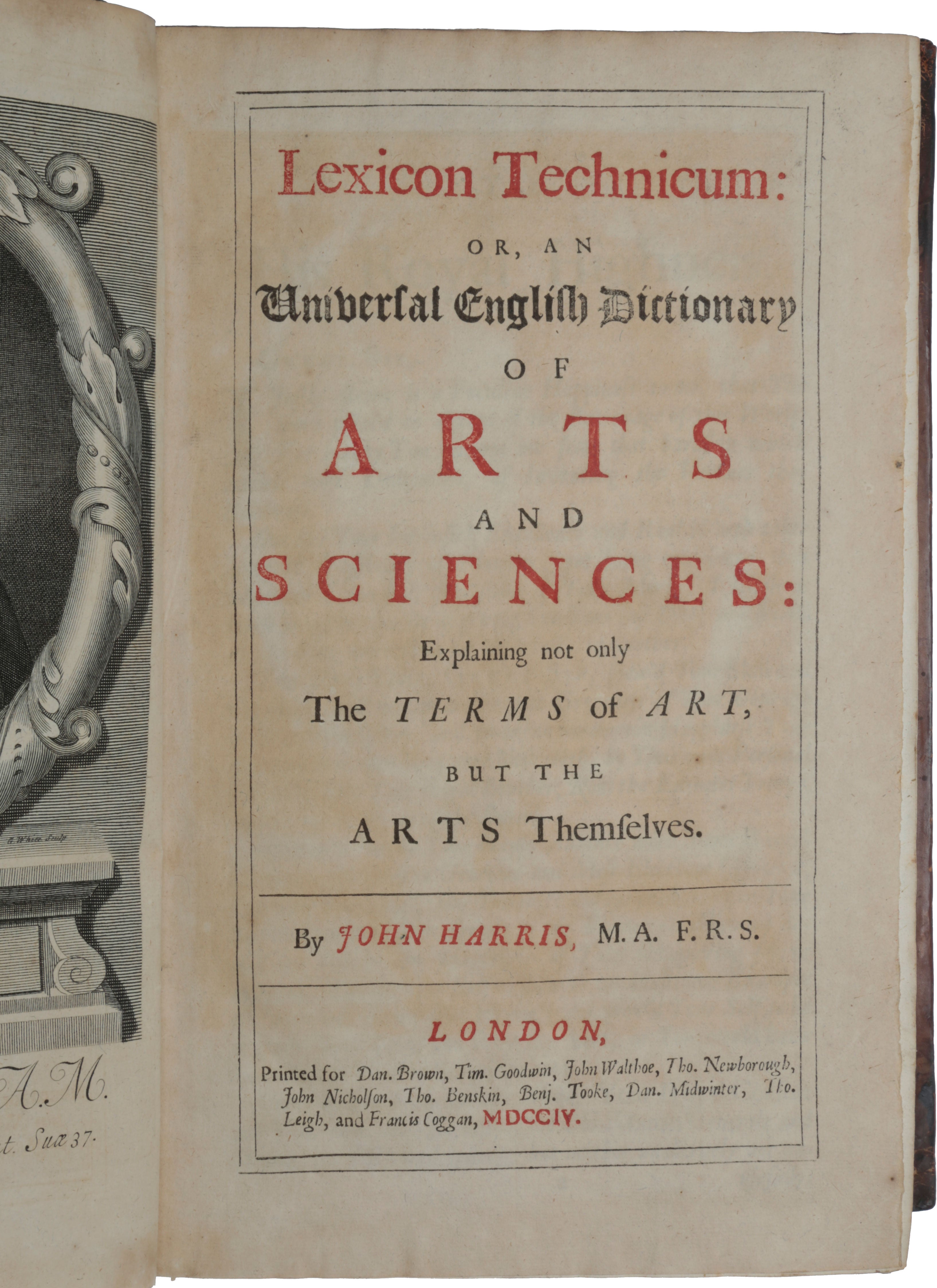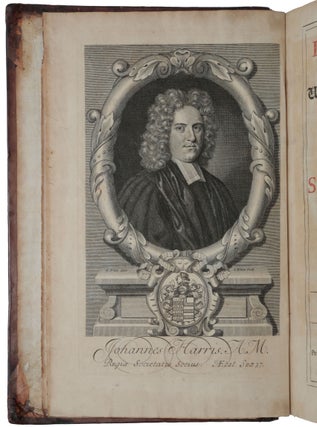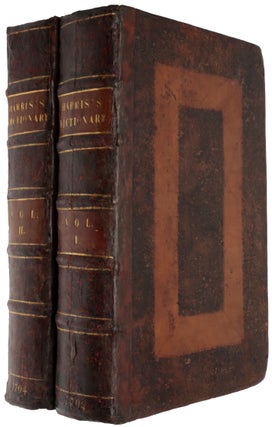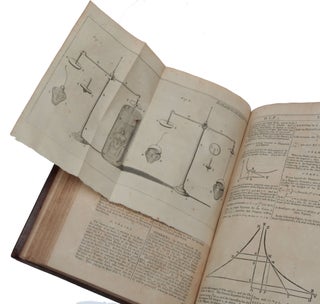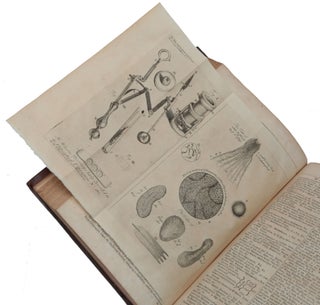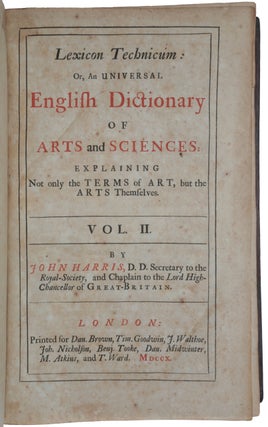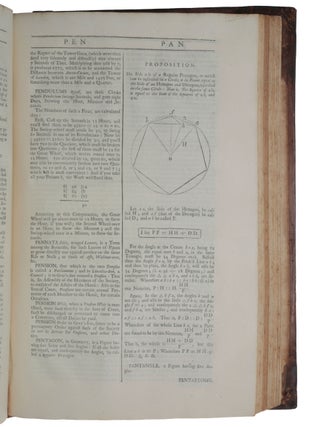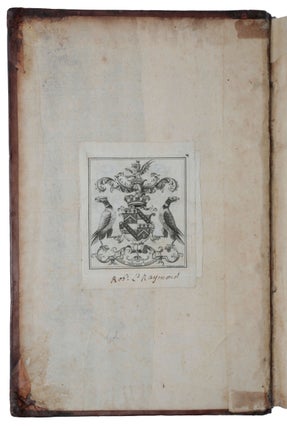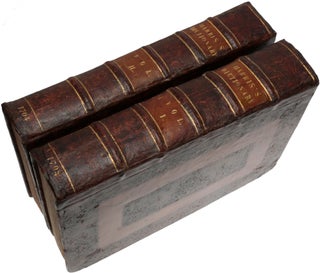Lexicon Technicum: or, an Universal English Dictionary of Arts and Sciences: Explaining not only the Terms of Art, but the Arts Themselves.
London: Printed for Dan Brown, Tim. Goodwin, John Walthoe, Tho. Newborough, John Nicholson, Tho. Benskin, Benj. Tooke, Dan. Midwinter, Tho. Leigh, and Francis Coggan, 1704-10. First edition of perhaps the most important single source for the history of science and engineering at the end of the scientific revolution. Its emphasis on technology, comparatively poorly covered by seventeenth century books, is particularly valuable primary material, while the author’s access to Newton and others has been frequently emphasized. “Harris’ most famous work was the Lexicon technicum, the first edition of which appeared in 1704. This was the first general scientific encyclopedia, and for it Harris drew upon some of the greatest authorities of the day. In physics, astronomy, and mathematics he turned to Newton; in botany he consulted John Ray and Joseph Tournefort; in other areas he drew upon Halley, Robert Boyle, Nehemiah Grew, John Woodward, John Wilkins, William Derham, and John Collins” (DSB). “The preface of vol. I mentions Newton many times as a source, and lengthy excepts from his works appear under such headings as comets, fluxions, gravity, heat, moon, motion, telescopes, tides …” (Babson). “John Harris … was the earliest lexicographer to distinguish between a word-book (dictionary, in modern parlance) and a subject-book (encyclopaedia proper), thereby overcoming the confusion which Isidore had introduced a thousand years earlier. His Lexicon technicum appears to be the first technical dictionary in any language. The most famous of his contributors was Isaac Newton” (PMM 171a). “Harris, who was an improvident divine and scientist, gave emphasis to practical and scientific subjects at the expense of the humanities. As a Fellow of the Royal Society (and its acting Vive-President for a time), he had ready access to many of the greatest scholars of the day, and his use of the works of such scientists as Ray and Newton is probably the first example of an encyclopaedia-maker drawing directly on the advice and help of experts and, as such, is the original precursor of the modern system of inviting contributions from specialists … Harris’s encyclopaedia was distinguished not only for its excellent plates, but also for its text-line drawings and diagrams, and for its provision of bibliographies of the more important scientific subjects. So far, England had been translating French encyclopaedias for domestic use; within a few years the leading French encyclopaedia was to be based on the English works of Harris and his successors … to Harris must go the honours of compiling the first true English encyclopaedia” (Collison, p. 99 & 103). A second edition of vol. I was published in 1708, two years before the first edition of vol. II, and it is relatively unusual therefore to find the first edition of both volumes together. The subscription list in Vol. II has Newton down for a large paper copy of the Lexicon. Provenance: Armorial bookplate of Robert Raymond, one of the subscribers, on front pastedown of each volume, with motto Aequam Servare Mentem. First volume inscribed ‘June 29, 1704’ on front free endpaper. “John Harris (1666-1719) was one of the most influential mathematics teachers in London, and one of the first to adopt Newton’s natural philosophy. He was elected Fellow of the Royal Society in 1696, and for a short period (1709-10) he was Secretary, but he suffered Hans Sloane’s opposition. In 1698 he delivered the Boyle lectures at St Paul’s Cathedral. As a teacher, Harris was never connected with an institution: in around 1698 he began to give free public lectures on mathematics at the Marine Coffee-House in Birchin Lane … Harris’s most successful work was the Lexicon Technicum, a huge scientific dictionary in two volumes” (Guicciardini, p. 14). “Although Newton’s influence on science and on philosophy was primarily produced by the Principia, the men and women of the eighteenth century were aware that the Newtonian philosophy embraced more than the combination of mathematics and empirical evidence which characterized that great work. We may gain some insight into the ways in which Newton influenced science and philosophy by reference to the Lexicon Technicum of John Harris … “Not surprisingly, the primary entry in the Lexicon Technicum under the heading ‘NEWTONIAN Philosophy’ is ‘the doctrine of the universe, and particularly of the heavenly bodies; their laws, affections, etc., as delivered by Isaac Newton.’ The dictionary, however, goes on to record some other senses in which at that time the term ‘Newtonian philosophy’ was used. One further sense was ‘the corpuscular philosophy, as it now stands corrected and reformed by the discoveries and improvements made in several parts thereof by Sir I. Newton.’ As the Lexicon explains, this aspect of ‘Newtonian philosophy’ was primarily founded on the third book of Newton’s Opticks (the part containing the Queries) and sundry papers such as the ‘De natura acidorum,’ first published in 1710 in the second volume of Harris’s Lexicon. “A third meaning of the term ‘Newtonian Philosophy,’ according to the Lexicon, was ‘the method or order which Sir I. Newton observes in philosophizing.’ This ‘method’ of doing science was said to consist of the ‘drawing of conclusions directly from phaenomena, exclusive of all previous hypotheses; the beginning from simple principles; deducing the first powers and laws of nature from a few select phaenomena, and then applying those laws, etc., to account for other things.’ “The fourth and fifth meanings of ‘Newtonian Philosophy,’ as given in the Lexicon, refer rather particularly to the Principia. The third equates the ‘Newtonian Philosophy’ with the ‘Mechanical and Mathematical Philosophy.’ In this philosophy, ‘Physical bodies are considered mathematically; and … geometry and mechanics are applied to the solution of phaenomena.’ The fourth meaning is ‘that part of physical knowledge, which Sir I. Newton has handled, improved, and demonstrated in his Principia.’ Finally, there is the sixth sense of this term: ‘the new principles which Sir I. Newton has brought into philosophy; the new system founded thereon; and the new solution of phaenomena thence deduced; or that which characterizes, and distinguishes his philosophy from all others’” (Cambridge Companion, pp. 29-30). The important Newtoniana in the Lexicon, including first or first English publications of a number of texts, may be summarized as follows. In vol. I the article ‘Moon’ is a translation of Newton’s ‘Theory of the Moon’s motion,’ first published in Latin in David Gregory’s Astronomiae physicae (1702) and also in English as a rare pamphlet A New and Most Accurate Theory of the Moon’s Motion in the same year. The English text printed by Harris is, however, slightly altered or edited (see Cohen, Isaac Newton’s theory of the moon’s motion, 1975). In vol. II, Newton’s only published work on chemistry, ‘De natura acidorum,’ is published for the first time (in the introduction). This is Newton’s account of bodies in terms of hierarchies of increasingly complex aggregations of particles held together by short-range attractive forces. Harris states that this work was composed in 1692, that he printed the paper with Newton’s permission and that the translation into English had been read and approved by Newton. Newton’s chemical theories were held in great esteem for many years. Also in vol. II the articles ‘Quadrature’ and ‘Curves’ are the first English translations of important mathematical papers which were appended to the first edition of Opticks (1704) but omitted from later editions. “John Harris, who inserted an English translation of Newton’s ‘De quadratura’ in the second volume of the Lexicon Technicum did not feel the need to change the substance of the article ‘Fluxions’ published in the first volume, where we read: ‘by the Doctrine of Fluxions, we are to understand the Arithmetick of the Infinitely small Increments of Decrements of Indeterminate or Variable Quantities, or as some call them the Moments or Infinitely small Differences of such variable Quantities. These infinitely small Increments or Decrements, our Incomparable Mr. Isaac Newton, calls very properly by the Name of Fluxions.’ “In the second volume, Harris continued the article ‘Fluxions’ with a ‘general method of Finding the Fluxion of all Powers and Roots, I had from the Honourable Fr. Robartes, Esquire.’ Harris wrote: ‘If a Quantity gradually increases or decreases, its immediate Increment or Decrement is called its Fluxion. Or the Fluxion of a Quantity is its Increase or Decrease indefinitely small’” (Guicciardini, p. 42). “Astronomers in the 17th century understood that the motion of the Moon was far more complex than those of the planets. The Hellenistic astronomers, Hipparchos and Ptolemy, had identified two major perturbations, corresponding respectively to a steady rotation of the line of apses and to fluctuations of the line of apses and the eccentricity; the latter was called the ‘evection’ by Bouillau. Tycho Brahe had found a further anomaly, the ‘variation’. Jeremiah Horrocks (1673) proposed a model of the Moon’s orbit as a rotating ellipse that was successful for its day. The orbit is distorted from a simple ellipse by the variation and the evection, the major axis (apse line) advances through 2π in about 9 years, the nodes regress by 2π upon the ecliptic in about 18 years, and there are further lesser perturbations. The largest anomaly is the evection with an amplitude of 1°16′ and a period of about 32 days, while the amplitude of the variation is about 35 arcmin with a period of nearly 15 days. “In Book I, Prop. LXVI of the first edition of Principia (1687), Newton discussed the dynamical problem of three bodies in a general way, and then in Book III he asserted that the vagaries of the Moon’s motion could be accounted for by the gravitational attraction of the Sun. He recognized that he needed to develop the theory further, and summarized his later results in The theory of the Moon's motion of 1702 … “Newton’s lunar results fall into three groups. He gives full, explicit successful treatments of the variation (for a circular orbit), of the motion of the node, and of the oscillations of the inclination. He states the results of his gravitational calculations of some small terms. Finally there is his very detailed but erroneous theory of rotating orbits … Newton’s failures should not obscure his great achievement in fundamental dynamics. He was the first to attack the problem of three bodies each attracting the other” (Cook, https://academic.oup.com/astrogeo/article/41/6/6.21/225623). The theory of the Moon's motion “is not well known, and its relationship to the dynamical theory of the Principia is problematic. It ‘contains a set of procedural rules to be used in making tables of the moon’s position’. Such a practical design is foreign to the Principia, and the procedural rules themselves are not derivable in any obvious way from Newton’s dynamical theory … Cohen thinks it is likely that Newton’s procedural rules were, in fact, used in the construction of some eighteenth-century tables … “The Scholium to Proposition 35, Book III, first appearing in the second edition of the Principia (1713), summarizes or restates some of the new rules first published in 1702 in the ‘Theory of the Moon.’ In the scholium Newton affirms the importance of the theory of gravity for deriving the procedural rules found in the ‘Theory of the Moon’, whereas in that treatise such an affirmation is noticeably lacking” (Chandler). Cohen (1975) shows that the original text of the 1702 ‘Theory of the Moon’ was composed in English and that the Latin version in Gregory’s Astronomiae physicae was a translation from the original English, probably by Gregory rather than by Newton himself. He speculates that A New and Most Accurate Theory of the Moon’s Motion was probably translated by Harris or by Halley. In view of its inclusion in the Lexicon, the former must be very likely. In the ‘De natura acidorum’ “Newton places great importance on the relative sizes of water, acid, and metallic corpuscles, the last of which he now refers to as ‘earthy’ particles. Water is composed of extremely minute corpuscles, acid of bigger ones, and earthy particles are bigger yet … Newton envisions the dissolution of metals in acid as a process that results in the coating of a central kernel with an acidic shell. Here, however, he views the combination of acid and earthy particles as making up a salt, rather than thinking of the salt as resident only in the ‘saline spirits’ of the acid. Newton also adds that acid particles can in some circumstances eventually penetrate into the earthy core to compose ‘sulphureous’ or ‘fatty bodies’ that are difficult to mix with water. The conversion of salts into sulfurous oils was a theme dear to the heart of Helmontians, and Newton’s laboratory notebooks contain passages excerpted from George Starkey on this very subject. What cements Newton’s debt to the Helmontian shell-theory, however, is a passage where Newton affirms that ‘what is said by chemists, that everything is made from sulphur and mercury, is true, because by sulphur they mean acid, and by mercury they mean earth.’ Hence Newton’s image of acid particles surrounding earthy ones as a shell does a kernel was another way of saying – as Philalethes did – that the sulfurous shell encloses the mercurial one. And since Newton here affirmed that ‘everything’ is made of sulfur and mercury, the shell-theory was applicable to the material world as a whole. As if to underscore his Helmontian allegiances, Newton then apparently dictated to his scribe that ‘all things can be reduced into water’” (Cambridge Companion, pp. 364-365). Babson, Supplement, p. 55; Collison, Encyclopaedias: their history throughout the ages (1966), p. 99; ESTC T142411 & T142408; Horblit 25a; Norman 992; PMM 171a; Wallis 383.5-383.501; Wells, Circle of Knowledge (1968) 16. Bradshaw, ‘John Harris’s Lexicon technicum,’ in: Kafker, Notable Encyclopedias of the Seventeenth and Eighteenth Centuries, pp. 107-119 (”the first general encyclopedia to emphasise science”). Chandler, Review of Cohen (1975), Isis 67 (1976), pp. 638-9. Cohen, Isaac Newton’s Theory of the Moon’s Motion (1702), 1975. Cohen & Smith (eds.), The Cambridge Companion to Newton, 2002. Collison, Encyclopaedias: Their History throughout the Ages, 1964. Cook, ‘Success and failure in Newton’s lunar theory,’ Astronomy & Geophysics 41 (2000), pp. 6.21-6.25.
Two vols., folio (324 x 220mm). Vol. I: pp. [924], with 7 engraved plates (3 of them with an inserted leaf of text), engraved portrait by G. White after R. White, title printed in red and black, engraving of chemical symbols on Q4v and numerous woodcut illustrations in text. Vol. II: pp. [632], 44, [1], 120, [60], with 7 engraved plates and two leaves of explanatory text inserted before a1, title printed in red and black, numerous woodcut illustrations in text (scattered light foxing, several plates in vol. 1 browned). Contemporary panelled calf, spine with raised bands and brown morocco spine labels, some restoration to to spines and boards.
Item #5408
Price: $16,500.00

